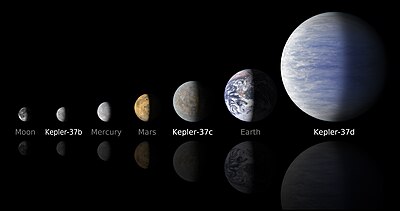List of smallest exoplanets

A size comparison of the planets in the Kepler-37 system and objects in the Solar System
Below is a list of the smallest exoplanets so far discovered, in terms of physical size, ordered by radius. Some of these are unconfirmed and/or controversial.
List[]
The sizes are listed in units of Earth radii (REarth). All planets listed are smaller than Earth, up to 0.7 Earth radii. The NASA Exoplanet Archive is used as the main data source.[1][2]
| Exoplanet | Radius (REarth) | Notes and references |
|---|---|---|
| SDSS J1228+1040 b (SDSS J122859.92+104033.0 b, WD 1226+110 b) |
0.0101+0.0504 −0.0085 |
Extrasolar planetesimal. Remnant iron core.[3] |
| PSR B1828-11 b | 0.016 | Unconfirmed, controversial[1] |
| Ceres | 0.07466 | Shown for comparison |
| WD 1145+017 b | ~0.15 | Extrasolar planetesimal.[4] |
| Pluto | 0.1825 | Shown for comparison |
| Moon | 0.2739 | Shown for comparison |
| Kepler-37b | 0.296±0.037 | Smallest known exoplanet.[5] |
| Kepler-1520b | ~0.3 | Disintegrating planets with poorly known radii, all thought to be smaller than Mercury.[6][7] |
| K2-22b | ||
| PSR B1257+12 b (Draugr) | ~0.338 | Least massive known exoplanet, at 0.02 Earth masses. Radius estimated from mass-radius relationship.[8] |
| Kepler-37e | 0.37±0.18 | Dubious[9] |
| Mercury | 0.3825 | Shown for comparison |
| Kepler-444b | 0.403+0.016 −0.014 |
[10] |
| Kepler-102b | 0.47±0.02 | |
| Kepler-444c | 0.497+0.021 −0.017 |
[10] |
| (KOI-4777.01) | 0.51±0.03 | [11] |
| 0.52+0.06 −0.05 |
||
| Kepler-138b | 0.522±0.032 | |
| Kepler-444d | 0.530+0.022 −0.019 |
[10] |
| Mars | 0.5314 | Shown for comparison |
| Kepler-62c | 0.54±0.03 | |
| Kepler-444e | 0.546+0.017 −0.015 |
[10] |
| KOI-115.03 (Kepler-105d) | 0.55+0.08 −0.07 |
Unconfirmed[12] |
| Kepler-42d | 0.57±0.18 | |
| Kepler-102c | 0.58±0.02 | |
| 0.59 | Unconfirmed | |
| 0.60+0.09 −0.05 |
||
| 0.61+0.17 −0.05 |
||
| 0.615±0.080 | ||
| 0.624 | ||
| 0.64+0.07 −0.05 |
||
| UCF-1.02 | 0.64 | Dubious[13][14] |
| 0.645 | ||
| 0.65+0.05 −0.04 |
||
| 0.65+0.09 −0.06 |
||
| UCF-1.01 | 0.65 | Dubious[13][14] |
| 0.66±0.05 | ||
| Kepler-431c | 0.668 | |
| 0.68+0.06 −0.04 |
||
| 0.69±0.04 | ||
| 0.69±0.05 | ||
| (EPIC 201497682 b) | 0.692+0.059 −0.048 |
|
| 0.696±0.044 | ||
| 0.700+0.630 −0.110 |
||
| 0.70±0.05 | ||
| 0.705+0.096 −0.085 |
||
| 0.71+0.06 −0.04 |
||
| Gliese 367 b | 0.718±0.054 | Smallest known exoplanet within 10 parsecs. |
See also[]
References[]
- ^ a b Staff (10 July 2017). "Exoplanet Catalog". Extrasolar Planets Encyclopaedia. Retrieved 10 July 2017.
- ^ "Planetary Systems Composite Data". NASA Exoplanet Archive. Retrieved 12 December 2021.
- ^ "Planet SDSS J1228+1040 b". exoplanet.eu. Retrieved 2019-08-05.
- ^ Vanderburg, Andrew; John Asher Johnson; Rappaport, Saul; Bieryla, Allyson; Irwin, Jonathan; John Arban Lewis; Kipping, David; Brown, Warren R.; Dufour, Patrick; Ciardi, David R.; Angus, Ruth; Schaefer, Laura; Latham, David W.; Charbonneau, David; Beichman, Charles; Eastman, Jason; McCrady, Nate; Wittenmyer, Robert A.; Wright, Jason T. (2015). "A disintegrating minor planet transiting a white dwarf". Nature. 526 (7574): 546–549. arXiv:1510.06387. Bibcode:2015Natur.526..546V. doi:10.1038/nature15527. PMID 26490620. S2CID 4451207.
- ^ Simukoff, E.; et al. (2013). "Below One Earth Mass: The Detection, Formation, and Properties of Subterrestrial Worlds". arXiv:1308.6308. Bibcode:2013SSRv..180...71S. doi:10.1007/s11214-013-0019-1. S2CID 118597064. Cite journal requires
|journal=(help) - ^ Ansdell, M.; Hirano, T.; Gaidos, E. (2019). "Monitoring of the D doublet of neutral sodium during transits of two 'evaporating' planets". Monthly Notices of the Royal Astronomical Society. 485 (3): 3876–3886. arXiv:1903.06217. doi:10.1093/mnras/stz693.
[...]the radii are not known but are thought to be smaller than Mercury (0.36R⊕).
- ^ Garai, Z. (2018). "Light-curve analysis of KOI 2700b: The second extrasolar planet with a comet-like tail". Astronomy & Astrophysics. 611: A63. arXiv:1712.07461. Bibcode:2018A&A...611A..63G. doi:10.1051/0004-6361/201629676. S2CID 118885868.
We confirmed the disintegrating-planet scenario of KOI 2700b.
- ^ "Exoplanet-catalog".
- ^ Rajpaul, V. M.; Buchhave, L. A.; Lacedelli, G.; Rice, K.; Mortier, A.; Malavolta, L.; Aigrain, S.; Borsato, L.; Mayo, A. W.; Charbonneau, D.; Damasso, M.; Dumusque, X.; Ghedina, A.; Latham, D. W.; López-Morales, M.; Magazzù, A.; Micela, G.; Molinari, E.; Pepe, F.; Piotto, G.; Poretti, E.; Rowther, S.; Sozzetti, A.; Udry, S.; Watson, C. A. (2021), "A HARPS-N mass for the elusive Kepler-37d: A case study in disentangling stellar activity and planetary signals", Monthly Notices of the Royal Astronomical Society, 507 (2): 1847–1868, arXiv:2107.13900, doi:10.1093/mnras/stab2192
- ^ a b c d Campante, T.; et al. (2015). "KOI-3158: The oldest known system of terrestrial-size planets". EPJ Web of Conferences. 101: 02004. arXiv:1501.07869. Bibcode:2015EPJWC.10102004C. doi:10.1051/epjconf/201510102004. S2CID 16191462.
- ^ Cañas, Caleb I.; Mahadevan, Suvrath; Cochran, William D.; Bender, Chad F.; Feigelson, Eric D.; Harman, C. E.; Kopparapu, Ravi Kumar; Caceres, Gabriel A.; Diddams, Scott A.; Endl, Michael; Ford, Eric B.; Halverson, Samuel; Hearty, Fred; Jones, Sinclaire; Kanodia, Shubham; Lin, Andrea S. J.; Metcalf, Andrew J.; Monson, Andrew; Ninan, Joe P.; Ramsey, Lawrence W.; Robertson, Paul; Roy, Arpita; Schwab, Christian; Stefánsson, Guđmundur (2022). "A Hot Mars-sized Exoplanet Transiting an M Dwarf". The Astronomical Journal. 163 (1): 3. arXiv:2112.03958. Bibcode:2022AJ....163....3C. doi:10.3847/1538-3881/ac3088. S2CID 244954104.
- ^ "Kepler-105". NASA Exoplanet Archive. Retrieved 12 December 2021.
- ^ a b Stevenson, Kevin B.; et al. (2014). "A Hubble Space Telescope Search for a Sub-Earth-sized Exoplanet in the GJ 436 System". The Astrophysical Journal. 796 (1). 32. arXiv:1410.0002. Bibcode:2014ApJ...796...32S. doi:10.1088/0004-637X/796/1/32. S2CID 118412895.
- ^ a b Lanotte, A. A.; et al. (2014). "A global analysis of Spitzer and new HARPS data confirms the loneliness and metal-richness of GJ 436 b". Astronomy and Astrophysics. 572. A73. arXiv:1409.4038. Bibcode:2014A&A...572A..73L. doi:10.1051/0004-6361/201424373. S2CID 55405647.
Categories:
- Lists of exoplanets